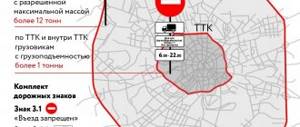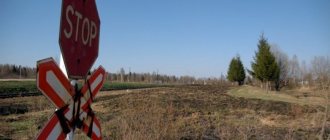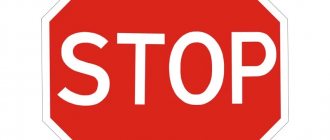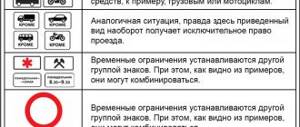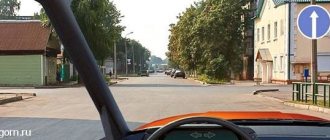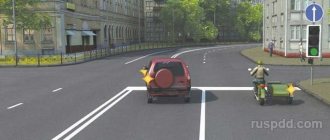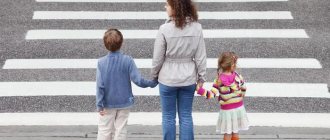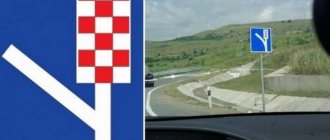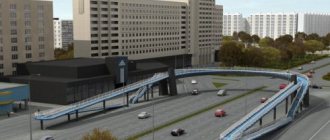Information signs
Crosswalk
Such a sign informs pedestrians that there is an opportunity to cross the roadway on a specific section of the road. It has a square shape. And the same sign, but triangular in shape, is intended for motorists, who must be extremely careful in this area and allow pedestrians to pass.
According to traffic regulations, such an information sign should be installed near a zebra crossing, a special marking on the road along which pedestrians should move when driving through the roadway.
Underground crossing
Also serves as an information sign. And he informs citizens about the presence of an underground passage, which must be used if necessary to cross the road. It is especially important to teach this sign to children so that they always use the underground passage and not run across the roadway.
Bus stop
Designed to inform citizens that route vehicles are stopping at a given location. This sign must be installed directly at the passenger boarding area. It has a rectangular shape with a picture of a bus inside.
Tram station
The meaning is similar to the previous sign, only it will carry information about the immediate place where the trams stop. It will be easier for pedestrians to find their way if there are such signs on the street.
It is also installed in close proximity to where the vehicle stops. It is very important to explain to young children the rules of behavior in such places, and how dangerous it can be if they suddenly run out onto the roadway.
Types of symbols indicating the road for pedestrians
There are several types of markings related to zebra crossings. Each is installed depending on where exactly and how the safety island is located for people crossing the road. What the “Pedestrian Crossing” signs have in common is that despite their external differences, they require compliance with the same rules.
Sign "Pedestrian crossing", "Children"
Young pedestrians often cross the road in places unsuitable for this. To protect children from the worst, responsibility for their safety falls partly on motorists. There is a symbol 1.23, which means that in its coverage area there is a high probability of a child suddenly appearing on the roadway. It is a triangle bordered in red, on a white background of which two running figures of people are depicted. What are the features of 1.23:
- Drivers should be attentive if they see a combination of signs “Pedestrian crossing” and “Children”.
In this case, they must not only prepare for the appearance of a child on the roadway, but also be sure to let him through if he has already stepped onto the zebra crossing.
- He may be on the road and alone. 1.23 warns the driver that it is worth slowing down on this section of the route. The sign is placed near schools, kindergartens, and other institutions intended for young road users.
- Next to 1.23 there should be a designation 8.2.1, establishing the length of the section where it is valid. If this zone does not have a zebra crossing and a symbol informing about it, it is not intended for pedestrians. And a child crossing the road under the “Children” picture has no advantage. If a collision occurs, the driver is not considered guilty provided that he was moving at the permitted speed and did not violate other rules.
For ground
A warning sign “Pedestrian crossing” is placed if the path for people to follow along the roadway is located directly on its surface. In the traffic rules it has the number 1.22, it looks like a white triangle with a red border, which depicts the figure of a man walking along a zebra crossing. The symbol informs the driver in advance that a pedestrian area will soon appear on his route. It is not placed directly next to the zebra crossing.
For it there are auxiliary designations 5.19.1 or 5.19.2. The first is a blue square with a white triangle in it. And inside there is a picture of a man walking to the left. On 5.19.2 it goes to the right, but otherwise the symbol looks like 5.19.1. Both of these can be replaced by markup 1.14.1 and 1.14.2.
More on AutoLex.Net:
What does the “Water Protection Zone” sign indicate, travel rules, installation according to GOST
For overhead
The “Pedestrian Crossing” road sign is also installed where the device by which people cross the roadway is located above it in the form of a bridge. A person does not step on its surface itself. And although the meaning of the existence of an overhead structure is still the same as a regular one, drivers will recognize its approach by symbol 6.7. This is a blue square, inside of which a man is depicted walking up the steps in white.
Aboveground devices are relatively new. Therefore, not everyone knows that if it is present, crossing the road in this place on the roadway is prohibited.
For underground
If the transition is made in the form of an illuminated underground tunnel, its designation in the traffic rules is numbered 6.6. The sign is similar to 6.7. But the man depicted on it is going down the steps.
If there is an underground device, the pedestrian also does not have the right to cross the road on the plane where cars are driving. This is a life-threatening violation of the rules.
Mandatory signs
Footpath
Such a sign, according to the traffic rules, is prescriptive. And it is installed in those places that are areas for pedestrians. That is, there cannot be any type of transport here, including bicycles.
Since pedestrians are full participants in the road traffic, as the traffic rules state, they must follow the general rules of behavior on the road. Namely, stick to the right lane while driving, and not create interference for other citizens.
A designation such as the beginning of a pedestrian zone will look like an image of a person in a circle on a blue background.
Bike Lane
It is also a prescriptive designation. In appearance it is similar to the sign about the beginning of a pedestrian path, but instead of a person, there is a picture of a bicycle.
Such a sign will indicate that bicycles and mopeds are allowed in this place. All other types of transport are prohibited here. Pedestrians can also walk on the bike path if there is no sidewalk nearby.
Such designated zones are created in cities specifically for movement on these types of transport. It is definitely worth teaching children to recognize this sign if it is available in the city. Then their cycling in the specified area will be safe.
Effective area of the Pedestrian Crossing sign
It is easier to understand where exactly it is allowed to cross the road if you are dealing with above-ground or underground structures. The bridge and tunnel are areas for crossing the roadway. But not the plane of the road under and above the devices along which cars move.
It is more difficult if we are talking about a ground zebra crossing. The following traffic regulations will help determine where the zone of coverage of the “Pedestrian Crossing” sign is located:
Pedestrian crossing is a section of the roadway marked with signs 5.19.1, 5.19.2 and (or) markings 1.14.1 and 1.14.2 and allocated for the movement of pedestrians across the road. In the absence of markings, the width of the pedestrian crossing is determined by the distance between signs 5.19.1 and 5.19.2.
That is, if there are these symbols without lines 1.14.1 and 1.14.2 on the road, you should navigate by them. If there is a zebra crossing, the width of its stripes is the transition. You cannot go beyond the limits, even if there are signs nearby.
Otherwise with warning symbol 1.22. Its coverage area is the same 50-100 or 150-300 m. But this does not mean that this is the area on which pedestrians can walk. 1.22 exists for drivers who, already at this distance, must slow down and be more careful.
Prohibition signs
Entry ban
This sign is classified as a prohibition sign. This sign means that further movement through the territory in front of which the sign is placed is not permitted. This applies to any vehicle, including bicycles. If a person on a bicycle needs to overcome a section of the road that is prohibited for transport, they simply need to continue further movement, but as a pedestrian, carrying their bicycle nearby.
This sign is known to everyone as a “brick”, a white rectangle in a circle on a red background. It is worth noting here that all signs that prohibit this or that action are red.
Bicycles are prohibited
A prohibitory sign looks like an image of a bicycle on a white background in a circle with a red frame. Its installation is appropriate in places where riding bicycles may be dangerous. These are usually busy sections of the road. Also, it is worth noting that you cannot ride a bicycle on the highway, even if there is no prohibiting sign there.
Pedestrian traffic is prohibited
In appearance, such a prohibitory sign is an image of a person crossed out with a red line, in a circle on a white background and in a red frame.
Also, they install it in places where, according to traffic regulations, it would be dangerous to move on foot. And this is not just a busy highway or highway. Such a sign can be installed as a temporary designation on certain sections of the road. For example. When road work is carried out, or repair work on house facades is carried out. Areas dangerous for pedestrians must be equipped with appropriate signs. And pedestrians, in turn, must know them and follow the rules.
What is the difference between installing a “Pedestrian crossing” sign?
How and where the symbol will be located depends on its type:
- if we are talking about 6.6 and 6.7, they are placed at the entrance and exit from underground and above-ground structures;
- for 1.22, the legal place is 50-100 m before the zebra crossing in a populated area and 150-300 m before it outside the city or village;
- 5.19.1 and 5.19.2 are located directly next to the transition;
- 1.23 should be located no closer than 50-100 m before the child care facility in the city, 150-300 m outside it (and also be duplicated after 50 m).
The size of the “Pedestrian Crossing” sign is chosen so that the distance does not interfere with seeing and identifying it. Parameters may vary depending on the type:
- 1st – 700 mm;
- 2nd – 900 mm;
- 3rd – 1200 mm.
For 5.19.1 and 5.19.2, the same standard sizes are 600, 700 and 900 mm, respectively.
The installation of a “Pedestrian Crossing” sign is subject to a number of conditions:
- the area should be well lit;
- it is located in a clearly visible area;
- if we are talking about a ground zebra crossing, there must be speed bumps on both sides of it;
- marking lines are made alternating in white and yellow colors;
- the symbol is framed in a glow-in-the-dark yellow frame, and a flashing light device of the same color may be installed next to it.
More on AutoLex.Net:
What does the adjacent territory mean in traffic rules, rules for driving along it
Pedestrian crossing sign rules
The presence of a zebra crossing means compliance with special conditions, primarily by motorists. The main rule of a pedestrian crossing sign is that a person has priority over a car if there is no traffic light. In the regulated area, you should focus on the signals of the light device.
For drivers, regardless of the type of crossing, there are other rules:
- U-turn prohibited;
- you cannot overtake;
- It is unacceptable to park at a distance of up to 5 m from it;
- cyclists and scooter riders must cross the zebra crossing on foot, driving their vehicles nearby.
Pedestrians are prohibited from crossing the road where there is a sign 3.10. If the offender managed to avoid being hit by a car or survive after it, he will be punished for violating traffic rules.
